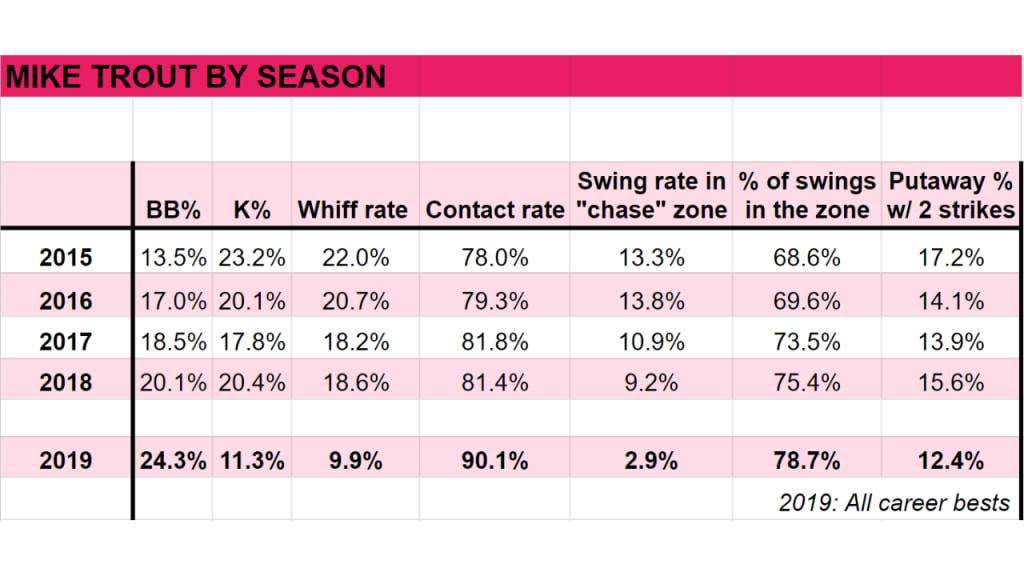Mike Trout is evolving again. It's a yearly thing, watching for Trout's adjustments that keep him at his consistent MVP level. Here's the 2019 upgrade: Trout isn't swinging and missing, he isn't chasing, and he isn't striking out.
Trout enters Tuesday's series opener against the Blue Jays leading the Major Leagues with 28 walks. He has only 13 strikeouts. He's walking more than twice as often as he's striking out, with a 24.3 percent walk rate to an 11.3 percent strikeout rate.
Trout has always walked, of course. He's led the AL in walks three times. His career on-base percentage is .418, he's led the AL three years running and he's at an AL-best .496 in 2019. But he used to also strike out a lot. That never hurt his elite production, but still, from 2012-16, he averaged 151 strikeouts a year, and had 1.6 K's for every walk.
In recent seasons, that's begun to shift. In 2017, for the first time in his career, Trout walked more times (94) than he struck out (90). Last season, he was close to even, with 122 walks and 124 strikeouts.
And that brings us to now. This is what's happening:

Trout is making more contact than ever
Trout has seen 445 pitches this season. He's swung at 151 of them; he's missed 15 times. That's fewer than one in every 10 swings. Or, to put it conversely, he's making contact on more than nine out of every 10 swings. Essentially, Trout has become an elite contact hitter.
Lowest swing-and-miss rate, 2019
Min. 100 swings (274 hitters)
- David Fletcher (LAA): 6.0%
- Willians Astudillo (MIN): 8.6%
3) Mike Trout (LAA): 9.9% (15 misses / 151 swings)
4) Wilmer Flores (ARI): 10.1%
5) Alex Verdugo (LAD): 10.2%
He's running the lowest swing-and-miss rate and highest contact rate of his career by far. Trout's whiff rate is basically half of what it was in 2017 (18.2 percent) and '18 (18.7 percent), which were his previous bests.
Trout is more selective than ever
Always a selective hitter, Trout has become even more so. He's only swinging at about a third of all pitches, his lowest swing rate in any season. When he does swing, he's concentrating those swings heavily within the strike zone.
More than three-fourths of Trout's swings have come on pitches in the zone -- 78.7 percent -- the ninth-highest proportion of the 189 players with 150-plus swings as of Tuesday morning. Nearly half of his swings, 47.7 percent, have been not just in the zone, but in the "heart" of the zone -- that is, within its interior, away from the edges -- also ninth-most.
Trout just doesn't swing at bad pitches. This season, pitchers have thrown him 139 pitches clearly outside the strike zone. He's swung at four of them. Trout's been hit by as many pitches as he's chased. His 2.9 percent swing rate on those "chase" pitches is the lowest in baseball.
By contrast, when a pitch is clearly in the strike zone, Trout has swung 62.6 percent of the time. That is to say: Trout has swung over 20 times more often when a pitch is clearly in the zone than when a pitch is clearly out of the zone. Of the 124 hitters who have seen both 100 clearly in-zone and clearly out-of-zone pitches so far this season, Trout's ratio of swings in the "heart" region to swings in the "chase" region is easily the best.
Highest ratio of "heart" swings to "chase" swings, 2019
Min. 100 pitches seen in both regions (124 hitters)
1) Mike Trout (LAA): 21.6x (62.6% heart, 2.9% chase)
2) Logan Forsythe (TEX): 18.9x (58.7% heart, 3.1% chase)
3) Tommy Pham (TB): 13.9x (74.8% heart, 5.4% chase)
4) Brian Dozier (WSH): 10.9x (65.2% heart, 6.0% chase)
5) Matt Chapman (OAK): 10.1x (64.4% heart, 6.4% chase)
Trout is harder to put away than ever
The narrowing of swing selection to the most hittable pitches is probably the largest reason behind Trout's 90.9 percent contact rate. Here's another: On the rare times Trout does go outside the zone, he's not missing often.
On Trout's swings against out-of-zone pitches -- most of which are borderline, anyway, just barely outside the strike zone's technical limits -- he's made contact 78.1 percent of the time. That's up by over 20 percent from last season, and it's one of the best rates in the Majors. His in-zone contact is up, too, to 93.2 percent, fifth-highest in MLB.
Even when you get him to two strikes, it's not easy to get that strike three. Trout's "putaway rate" this season -- the percent of two-strike pitches that result in a strikeout -- is down to a career-low 12.3 percent.
The confluence of factors -- fewer swings and misses, extreme patience, almost no chases, tons of contact inside and outside the strike zone -- is what's making Trout so hard to strike out.
That's how you get a Major League-best 2.2 walks for every strikeout. It's how you get the latest new look in Trout's perennial evolution.
